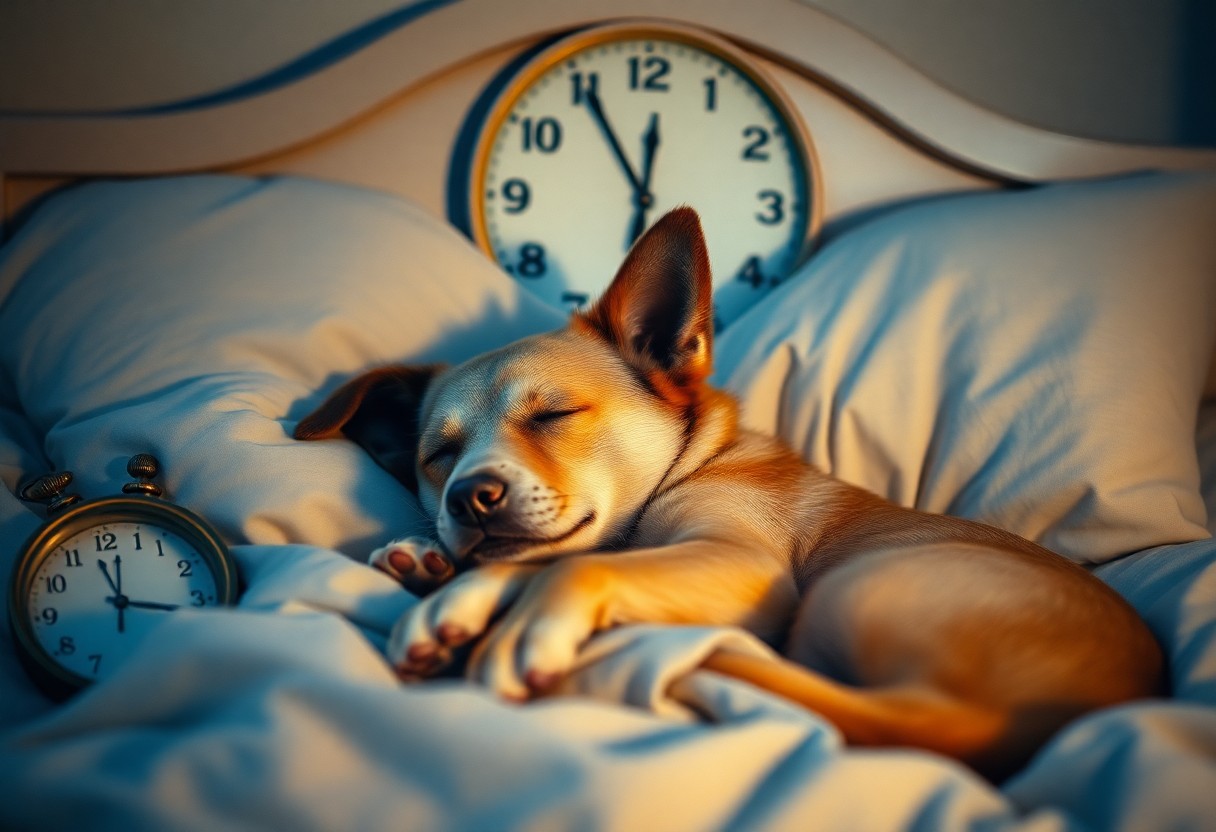Most dog owners wonder about the ideal amount of sleep for their furry friends. Your dog’s sleep needs vary depending on factors like age, breed, and health. Puppies and senior dogs typically require more rest, sometimes up to 18-20 hours daily, while adult dogs usually need around 12-14 hours. Ensuring your dog gets the right amount of sleep supports their physical health, mental well-being, and energy levels. Conversely, insufficient sleep can lead to behavioral issues and health problems, making it important for you to observe your dog’s sleeping patterns closely.

Understanding Canine Sleep Patterns
Before you determine how much sleep your dog needs, it’s important to understand that dogs have unique sleep patterns compared to humans. They cycle through different stages of sleep throughout the day and night, adjusting their rest based on activity levels, age, and environment. By grasping these patterns, you’ll gain insight into when your dog might be tired or unusually restless, helping you respond appropriately to their rest needs.
Overview of a Dog’s Sleep Cycle
To appreciate your dog’s sleep needs, you should first understand their sleep cycle, which includes periods of light sleep, deep sleep, and REM (rapid eye movement) sleep. This cycle allows dogs to recover physically and mentally. Unlike humans, dogs often sleep in short bursts throughout the day, totaling around 12 to 14 hours. Recognizing these patterns will help you identify whether your dog is getting sufficient rest or if adjustments to their routine are necessary.
Differences Between Puppies, Adults, and Seniors
Differences in sleep requirements among dogs largely depend on their age. Puppies typically sleep much more to support rapid growth, adults require moderate rest for maintaining health, and seniors often need extended sleep to aid in recovery and manage age-related fatigue. Paying attention to these distinctions will help you ensure your dog’s sleep schedule aligns with their life stage.
Puppies, in particular, need significantly more sleep than adult dogs, often sleeping up to 18-20 hours a day to fuel their development and immune system strengthening. Insufficient sleep during this stage can lead to behavioral issues and delayed growth. By contrast, adult dogs typically rest 12-14 hours, while senior dogs may increase sleep time due to decreased energy levels and potential health concerns. Monitoring these patterns helps you support your dog’s overall well-being effectively.
1. Puppies need 18-20 hours of sleep daily.
2. Adult dogs typically sleep 12-14 hours each day.
3. Senior dogs may require more sleep than adults.
4. Activity level affects how much rest a dog needs.
5. Watch for changes in sleep patterns indicating health issues.
6. Quality sleep supports your dog’s overall health and behavior.
Factors Influencing Sleep Duration
Some key factors determine how long your dog should be sleeping. These include your dog’s age, breed, activity level, and overall health status. Puppies and older dogs typically need more rest, while active dogs might require less sleep but more quality rest. Environmental conditions and stress levels can also impact sleep patterns. Recognizing these factors helps you provide the right environment and care for your dog’s sleep needs.
Breed-Specific Sleep Needs
Sleep requirements vary widely between breeds. Some smaller or highly energetic breeds like terriers may need less sleep overall but benefit from short naps during the day. Larger breeds, such as mastiffs or retrievers, often need more extended sleep periods to support their body size and energy reserves. Understanding your dog’s breed-specific sleep needs allows you to tailor their routine for optimal rest and health.
Activity Level and Physical Health
Physical exertion and health conditions directly impact how much sleep your dog needs. Active dogs who engage in regular exercise generally require more deep sleep to recover muscles and restore energy. Conversely, dogs with certain health issues or aging dogs might sleep more but rest less deeply, affecting their overall well-being.
Considering your dog’s activity level and physical health is necessary for assessing their sleep duration accurately. If your dog exercises vigorously, expect them to benefit from longer and more restorative sleep periods. Conversely, dog owners should watch for excessive or insufficient sleep, as both can indicate underlying health problems. Monitoring changes in sleep habits combined with your dog’s energy levels can help identify any potential health concerns early, ensuring your pet remains happy and healthy.
Signs of Proper Sleep
After ensuring your dog has an adequate place to rest, you need to observe signs indicating they are getting proper sleep. Content dogs typically wake up refreshed and energetic, their eyes clear and alert. You might notice relaxed breathing and a calm demeanor during naps. These indicators show that your dog’s sleep cycle is healthy and restorative, which supports their overall well-being and daily activity levels.
Recognizing a Healthy Sleeper
Recognizing a healthy sleeper involves seeing your dog settle quickly into rest, exhibit smooth breathing, and remain still for extended periods. Upon waking, they should display enthusiasm for play or interaction, demonstrating that deep, restful sleep was achieved. If your dog exhibits consistent sleeping patterns without restlessness, they are likely getting the rejuvenating sleep they need.
Common Sleep Disorders in Dogs
To maintain your dog’s health, you should be aware of common sleep disorders such as insomnia, sleep apnea, and restless leg syndrome. These conditions may cause your dog to wake frequently, show signs of anxiety, or appear unusually tired during the day. Watching for such symptoms can help you intervene early and seek veterinary advice if needed.
Healthy sleep is vital, but when disorders like sleep apnea or insomnia occur, they can significantly impact your dog’s quality of life. Some sleep disorders might increase risks of daytime fatigue or behavioral problems. Detecting signs early allows you to pursue treatment options, ensuring your dog returns to a comfortable and restorative sleep routine, which is important for their physical and mental health.
Tips for Improving Your Dog’s Sleep Quality
For enhancing your dog’s sleep quality, focus on factors that create a restful environment. Ensure your dog has a cozy bed, minimize loud noises, and regulate room temperature. Provide regular exercise and mental stimulation during the day to encourage better rest at night.
- Maintain a quiet, comfortable space
- Encourage daily physical activity
- Stick to a consistent schedule
- Avoid excessive stimulation before bedtime
The right habits will help your dog enjoy deeper, more restorative sleep.
Creating a Comfortable Sleeping Environment
For your dog to sleep well, you need to create a comfortable sleeping environment. Choose a supportive bed in a quiet area, away from drafts and distractions. Use soft blankets or cushions to enhance coziness. Maintaining a stable room temperature is also important to keep your dog comfortable throughout the night. By prioritizing a peaceful, secure spot, you can significantly improve your dog’s overall sleep quality.
Establishing a Routine
Comfortable sleep begins with establishing a consistent routine for your dog. Set regular times for meals, walks, and bedtime to create predictability and reduce anxiety. Keeping a daily rhythm helps your dog understand when to wind down and rest, promoting better sleep patterns. Consistency in your routine signals to your dog that it’s time to relax and recharge.
A well-structured daily routine supports your dog’s natural sleep-wake cycle. You should plan activities that allow for sufficient exercise and mental engagement, followed by calming periods before bedtime. Feeding your dog at the same times daily avoids disruptions in digestion that can interfere with sleep. Over time, your dog will associate the routine with comfort and security, resulting in improved sleep duration and quality. Avoid sudden changes, as they could lead to stress and disturb your dog’s rest.
How Much Sleep is Normal?
Despite popular belief, dogs need significantly more sleep than humans, with most adult dogs resting approximately 12 to 14 hours a day. Puppies and senior dogs often require even more sleep to support their development and recovery. Understanding the normal amount of sleep your dog needs helps you monitor their health and well-being, ensuring they stay happy and active.
Average Sleep Duration by Age and Size
Among dogs, sleep requirements vary primarily based on age and size. Puppies may sleep up to 18 to 20 hours daily to support growth, while adult dogs generally need 12 to 14 hours. Large breeds often rest longer than smaller ones, sometimes up to 16 hours, because their size demands more energy for daily function. Keeping track of your dog’s age and size will help you gauge if their sleep duration is normal or not.
Variations in Sleep Among Different Breeds
Beside age and size, breed also influences how much sleep your dog requires. Some breeds, like working dogs, tend to be more active and may sleep less, while companion or toy breeds often take longer naps throughout the day. Understanding your dog’s breed-specific sleep tendencies aids you in tailoring their daily routine for optimal health and comfort.
Size plays a significant role in breed-related sleep variations. Larger breeds such as Mastiffs or Saint Bernards commonly sleep more due to their slower metabolism and joint stress, which necessitates increased rest for physical recovery. Conversely, high-energy breeds like Border Collies may experience shorter, more intermittent sleep to accommodate their active lifestyles. Recognizing these breed-specific differences allows you to better interpret your dog’s behavior and detect any unusual changes that might signal health issues.
When to Be Concerned About Sleep Patterns
Not all changes in your dog’s sleeping habits are cause for alarm, but you should be alert to signs that suggest a disruption in their normal sleep cycle. If your pet is sleeping significantly more or less than usual or exhibiting restless behavior, these could be indicators that something is wrong. Monitoring these shifts can help you ensure your dog’s health and well-being, allowing you to address potential issues before they worsen.
Indicators of Sleep Problems
Concerned if your dog shows signs like frequent waking, excessive panting, or unusual restlessness during sleep? These could signify sleep disturbances such as anxiety, pain, or even underlying health conditions. Pay attention to any changes in your dog’s nighttime routine and energy levels, as these factors often point to sleep issues that might require your attention.
When to Consult a Veterinarian
To safeguard your dog’s health, seek veterinary advice if sleep problems persist or are accompanied by symptoms like lethargy, loss of appetite, or behavioral changes. An expert evaluation can help identify whether an underlying medical condition is disrupting their sleep and guide you towards effective treatment options.
Indicators that you should consult a veterinarian include persistent sleep disruptions combined with signs such as increased anxiety, frequent seizures, or visible pain. These symptoms may signal serious health issues that require professional intervention. Early veterinary consultation can lead to a more accurate diagnosis and prompt treatment, helping your dog return to a healthier sleep pattern and improving their overall quality of life.
Final Words
Following this, you now have a better understanding of how long your dog should be sleeping to maintain optimal health and happiness. Sleep needs vary by age, breed, and activity level, so tuning into your dog’s unique patterns is key. If you’re curious about the specifics or want more detailed guidance, check out How Many Hours a Day Should Dogs Sleep? to ensure you provide the best care for your furry friend.
 wagwagtail "only love can make your dog wag her tail"
wagwagtail "only love can make your dog wag her tail"
